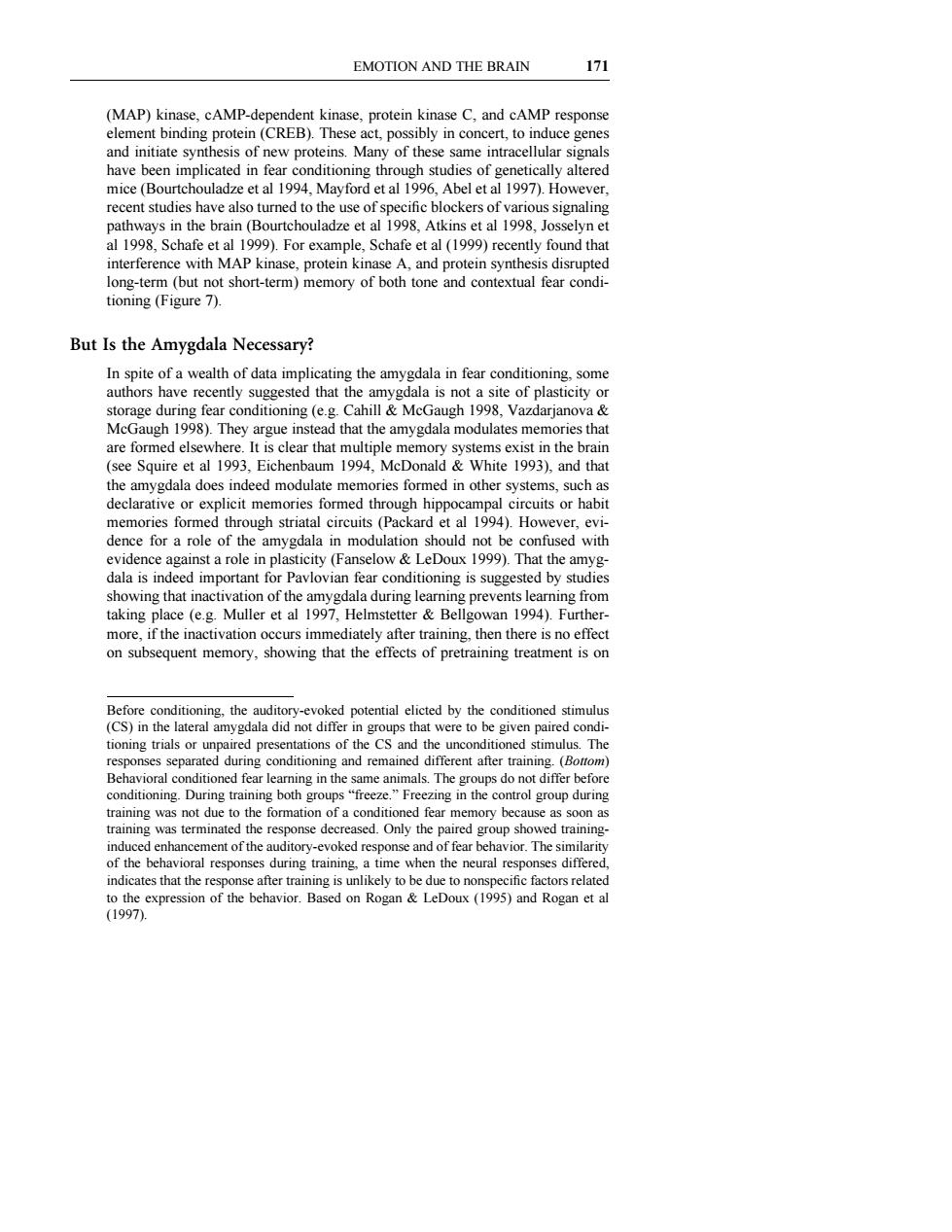正在加载图片...

EMOTION AND THE BRAIN 171 (MAP)kinase,cAMP-dependent kinase,protein kinase C,and cAMP response (CREB) mice(Bourtchouladze et al 1994.Mayford etal .Abel et al 1997).However. ntly found tha interference with MAP kinase,protein kinase A.and protein synthesis disrupted e)mmry of oh tone nd con But Is the Amygdala Necessary? storage during fear conditioning (e.g Cahill McGaugh 1998.Vazdarjanova& McGaugh 1998).They argue instead that the amygdala modulates memories that are formede the am ygdala does indeed modulate memories formed in other systems.such as declarativeor explicit memories formed through hippocampal ircuitsor habit lence for a rol t a role e amy ticity 1999)That th aisinddrant for Pasueeby er tioning Freezing in the conro group during upshowed The sm indicates that the res f the EMOTION AND THE BRAIN 171 Before conditioning, the auditory-evoked potential elicted by the conditioned stimulus (CS) in the lateral amygdala did not differ in groups that were to be given paired conditioning trials or unpaired presentations of the CS and the unconditioned stimulus. The responses separated during conditioning and remained different after training. (Bottom) Behavioral conditioned fear learning in the same animals. The groups do not differ before conditioning. During training both groups “freeze.” Freezing in the control group during training was not due to the formation of a conditioned fear memory because as soon as training was terminated the response decreased. Only the paired group showed traininginduced enhancement of the auditory-evoked response and of fear behavior. The similarity of the behavioral responses during training, a time when the neural responses differed, indicates that the response after training is unlikely to be due to nonspecific factors related to the expression of the behavior. Based on Rogan & LeDoux (1995) and Rogan et al (1997). (MAP) kinase, cAMP-dependent kinase, protein kinase C, and cAMP response element binding protein (CREB). These act, possibly in concert, to induce genes and initiate synthesis of new proteins. Many of these same intracellular signals have been implicated in fear conditioning through studies of genetically altered mice (Bourtchouladze et al 1994, Mayford et al 1996, Abel et al 1997). However, recent studies have also turned to the use of specific blockers of various signaling pathways in the brain (Bourtchouladze et al 1998, Atkins et al 1998, Josselyn et al 1998, Schafe et al 1999). For example, Schafe et al (1999) recently found that interference with MAP kinase, protein kinase A, and protein synthesis disrupted long-term (but not short-term) memory of both tone and contextual fear conditioning (Figure 7). But Is the Amygdala Necessary? In spite of a wealth of data implicating the amygdala in fear conditioning, some authors have recently suggested that the amygdala is not a site of plasticity or storage during fear conditioning (e.g. Cahill & McGaugh 1998, Vazdarjanova & McGaugh 1998). They argue instead that the amygdala modulates memories that are formed elsewhere. It is clear that multiple memory systems exist in the brain (see Squire et al 1993, Eichenbaum 1994, McDonald & White 1993), and that the amygdala does indeed modulate memories formed in other systems, such as declarative or explicit memories formed through hippocampal circuits or habit memories formed through striatal circuits (Packard et al 1994). However, evidence for a role of the amygdala in modulation should not be confused with evidence against a role in plasticity (Fanselow & LeDoux 1999). That the amygdala is indeed important for Pavlovian fear conditioning is suggested by studies showing that inactivation of the amygdala during learning prevents learning from taking place (e.g. Muller et al 1997, Helmstetter & Bellgowan 1994). Furthermore, if the inactivation occurs immediately after training, then there is no effect on subsequent memory, showing that the effects of pretraining treatment is on